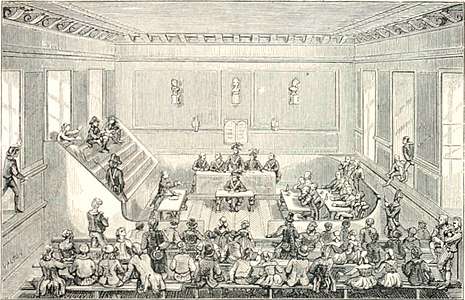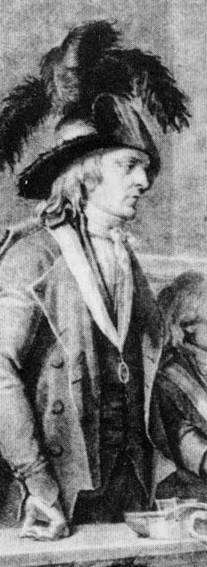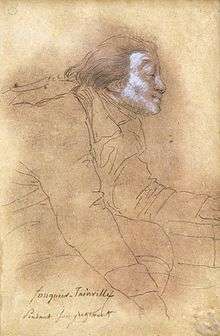Revolutionary Tribunal
The Revolutionary Tribunal (French: Tribunal révolutionnaire; unofficially Popular Tribunal)[1] was a court instituted by the National Convention during the French Revolution for the trial of political offenders. It eventually became one of the most powerful engines of the Reign of Terror.[2]

Origin

The provisional Revolutionary Tribunal was established on 17 August 1792 in response to the Storming of the Tuileries. To ensure that there was some appropriate legal process for dealing with suspects accused of political crimes and treason, rather than arbitrary killing by local committees, Maximilien Robespierre proposed that a new Tribunal be set up, with extraordinary powers to impose the death sentence.[3]:201 The Tribunal was abolished in November 1792 at the start of the trial of Louis XVI, and during this time had sentenced twenty-eight people to death. Mostly these were ordinary criminals rather than political prisoners.[3]:202[4]
The Revolutionary Tribunal was re-established at a time of crisis in the new French Republic. In the Spring of 1793, the war with the First Coalition was going badly and food shortages were worsening.[5]:325 The government responded by taking a number of measures to defend the integrity of the Republic. On 24 February the National Convention decided to create an army of 300,000 by means of a levée en masse;[5]:325 on 9 March it decided to send a représentant en mission from the Convention to every département.[5]:326
Even in these circumstances, the Convention was initially reluctant to restore the Revolutionary Tribunal. On 10 March, responding to serious disorder in the streets of Paris, Georges Danton, with Robespierre's support, proposed its revival, but the majority of deputés were not in favour. After a long debate, towards midnight, Danton was able to persuade a majority to vote for it only by raising the spectre of further uncontrolled massacres, as had taken place the previous September. If the Convention did not agree to create the Tribunal, he argued, the people would be compelled to make their own justice.[3]:235 “Let us be terrible, said Danton, so that the people will not have to be”.[6] On this basis, the Convention finally agreed that there should be established in Paris the Extraordinary Criminal Tribunal[7]:162[8] (Tribunal criminel extraordinaire), which received the official name of the Revolutionary Tribunal by a decree of 29 October 1793.[9]
Other measures taken in response to the crisis around the same time included the formal establishment of a Revolutionary Watch Committee in every neighbourhood[5]:328 and the creation of the Committee of Public Safety on 6 April.[5]:331
Form
The court was to hear cases of alleged counter-revolutionary offences from across France. It was composed of a jury of twelve. This was an innovation in French justice, borrowed from English law (although for the Revolutionary Tribunal the jury was carefully selected from politically reliable activists).[7]:162 It had five judges, a public prosecutor and two deputy prosecutors, all nominated by the Convention; and from its judgments there was no appeal.[9] Jacques-Bernard-Marie Montané became President of the Tribunal until he was replaced in his post on 23 August 1793 by M. J. A. Herman. Fouquier-Tinville served as public prosecutor. The lists of prisoners to be sent before the tribunal were prepared by a popular commission and signed, after revision, by the Committee of General Security and the Committee of Public Safety jointly.[9]
On 5 September 1793 the Convention declared that "terror is the order of the day" and split the Revolutionary Tribunal into four concurrent chambers so that the number of cases it dealt with could be greatly increased. It also decided that all jurors in the Tribunal should be directly appointed by the Committee of Public Safety or the Committee of General Security. This followed the news that rebels in Toulon had handed the city over to the British and several days of rioting in Paris.[3]:257–8
Operation
One of the earliest cases brought to the Tribunal led to its most famous acquittal. On 13 April 1793 Girondin deputés brought an accusation against Jean-Paul Marat. Crucially this involved waiving the immunity enjoyed up to then by members of the Convention (Marat was himself a deputé). Not only did the case against Marat collapse, but two days after his case was brought, members of the Paris Commune responded by bringing a case to the Tribunal against 22 leading Girondins. This case was dismissed but the principle that Convention members could be tried by the Tribunal was an important one, and ultimately led to the Girondin leaders being tried and executed in October 1793.[10][11][12]
During the months when Montané served as its President, the Tribunal dealt with 178 accused. 53% of these were set free after initial examination by a judge, without a full trial, while a further 17% were tried and acquitted by a jury. 5% were convicted and sentenced to imprisonment or deportation, and 25% were sentenced to death.[13] From its formation up to September 1793, the Tribunal heard 260 cases and handed down 66 death penalties. As a result, it was criticised as ineffective by some Jacobins.[4] The Law of Suspects (17 September 1793) greatly increased the number of prisoners who were imprisoned and might be brought to trial.[3]:257–8 Between October and the end of 1793 the Tribunal issued 177 death sentences.[4]
Similar tribunaux révolutionnaires were also in operation in the various French departments. However, on 16 April 1794 (27 Germinal Year II) the Convention approved a report by St. Just proposing the abolition of the existing revolutionary tribunals in individual départements and requiring all suspects to be sent to the main tribunal in Paris.[5]:417 On 21 May 1794 the government decided that the Terror would be centralised, with almost all the tribunals in the provinces closed and all the trials held in Paris.[14] The provincial tribunals which were allowed to continue their work were Bordeaux, Arras, Nîmes in the South, as well as Arras and Cambrai in the North.[15]
Following the attempted assassinations of Convention members Jean-Marie Collot d'Herbois on 23 May and Maximilien Robespierre on 25 May 1794, on 10 June (22 Prairial Year II) the so-called "Prairial Laws" were passed. These limited trials in the Revolutionary Tribunal to three days.[5]:426 They also prevented the Revolutionary Tribunal from calling witnesses, or from allowing defence counsel. Juries were to convict or acquit entirely on the basis of the accusation and the accused's own defence. Further, the new laws confined the Tribunal to only two possible verdicts – acquittal or death.[6]:837 Finally, the law cancelled all previous legislation on the same subject. Without being explicit, this removed the immunity of members of the Convention which up till then had protected them from summary arrest and required that the Convention itself vote to send any of its members to trial.[16]
Three days after the Prairial laws were passed, the guillotine was moved out of Paris. It had previously stood on the Place du Carrousel, was then moved to the Place de la Revolution, and then again to the Place St Antoine and later to the Place du Trône-Renversé. As the Revolutionary Tribunal accelerated the pace of executions, it became impractical to have it in the city.[5]:427
Criticism
The powers of the Revolutionary Tribunal were granted by the Convention, and there was only limited criticism of it. Royalists, émigrés and federalists were clearly opposed to the Tribunal and its workings, but since public criticism in Paris or in the press would be regarded as treasonable, it barely existed. At the same time, there were periodic demands from Enragés[17][18] and Hébertists[6]:806 that the Tribunal accelerate its work and condemn more of the accused.
Among the first to speak up publicly against the Tribunal was Camille Desmoulins in his short-lived journal, "Le Vieux Cordelier".[19] As a result of his criticisms he was expelled from the Jacobin Club. Later he was arrested, tried and executed together with Danton.[3]:286
On the eve of his execution, Danton expressed his regret for having advocated the Tribunal. "It was just a year ago that I was the means of instituting the Revolutionary Tribunal; may God and man forgive me for what I did then; but it was not that it might become the scourge of humanity."[20]
Although the Revolutionary Tribunal was not criticised directly in the Convention while Robespierre held power, his proposals for the Prairial Laws were met with dismay when they were presented to the Convention. Some of the deputies were uneasy, in particular, about the removal of their immunity. They agreed to the law when Robespierre insisted on it, but the following day attempted to amend it, obliging Robespierre to return to the Convention and make them restore the original version.[21]
After Thermidor

After the overthrow of Robespierre in July 1794, some people expected the Revolutionary Tribunal to be abolished, but this did not happen. In the five days after the Thermidorean Reaction, the Convention freed 478 political prisoners, but 8,000 still remained incarcerated, despite popular demands for a general amnesty.[5]:441
On 1 August 1794 (14 Thermidor Year II) the Prairial Laws were revoked, meaning that the burden of proof against suspects was once again with the prosecution. Soon afterwards, all of the judges on the Revolutionary Tribunal were replaced, and the local surveillance committees were curtailed, so that there were henceforth to be only twelve in Paris and one per district outside the capital.[5]:440 The Law on Suspects however remained in force.
The Revolutionary Tribunal was used by the Thermidorean Convention as an instrument to destroy the political leaders who had taken an active part in the Reign of Terror. On 16 December 1794 (26 Frimaire Year III) Jean-Baptiste Carrier was sentenced to death and executed.[5]:462 On 6 May 1795 (17 Floreal Year III), The former President of the Revolutionary Tribunal, Martial Herman, the former Chief Prosecutor Fouquier-Tinville and fourteen former jury members of the Revolutionary Tribunal were convicted, and the following day, guillotined.[5]:477 After most of those associated with the Reign of Terror had been eliminated, the Revolutionary Tribunal was finally suppressed on 31 May 1795 (12 Prairial Year III).[5]:479
While the Convention itself had most people associated with the Revolutionary Tribunal in Paris executed, no similar official process was followed in the provinces. In 1795, the First White Terror broke out in parts of the country, particularly in the South East, as anti-Jacobin mobs attacked and murdered people who had been associated with revolutionary tribunals in their area.[22] On 14 February 1795 for example, Joseph Fernex (fr), a judge on the former Orange Tribunal, was killed and thrown into the Rhône by a mob.[5]:468 On 27 June other members of the same tribunal received the same treatment.[5]:484
Assessment
From the beginning of 1793 to the Thermidorean Reaction, 17,000 people were sentenced and beheaded by some form of revolutionary court in France (in Paris or in the provinces), in addition to some 25,000 others who were summarily executed in the September Massacres, retributions in the War in the Vendée and elsewhere. The Paris Revolutionary Tribunal was responsible for 16% of all death sentences.[5]:437
Of all those accused by the Revolutionary Tribunal, about a half were acquitted (the number dropped to a quarter after the enactment of the Law of 22 Prairial Year II) (10 June 1794). Before 22 Prairial the Revolutionary Tribunal had pronounced 1,220 death-sentences in thirteen months; during the forty-nine days between the passing of the law and the fall of Robespierre 1,376 persons were condemned (an average of 28 per day).[9]
See also
References
| Wikimedia Commons has media related to Revolutionary Tribunal (1793-1795). |
- David Andress (ed.), The Oxford Handbook of the French Revolution, Oxford University Press, 2015, p. 447.
-

- Ruth Scurr (17 April 2007). Fatal Purity: Robespierre and the French Revolution. Henry Holt and Company. ISBN 978-0-8050-8261-6.
- Tulard, Jean. "Tribunal Révolutionnaire". universalis.fr. Encyclopædia Universalis. Retrieved 24 May 2018.
- Nevin, Louis (1989). Chronicle of the French Revolution. London: Longman. ISBN 0-582-05194-0.
- Schama, Simon (1989). Citizens. London: Penguin. p. 707. ISBN 0-14-008728-1.
- Andress, David (2005). The Terror: Civil War in the French Revolution. London: Abacus. ISBN 0-349-11588-5.
- Kelly, George Armstrong (1982). Victims, Authority and Terror. Chapel Hill: University of North Carolina Press. p. 125. ISBN 0-8078-1495-4.
- Chisholm 1911, p. 224.
- M A Kennedy; Michael L. Kennedy (2000). The Jacobin Clubs in the French Revolution, 1793–1795. Berghahn Books. p. 18. ISBN 978-1-57181-186-8.
- Lisa Rosner; John Theibault (26 March 2015). A Short History of Europe, 1600–1815: Search for a Reasonable World. Routledge. p. 363. ISBN 978-1-317-47792-1.
- David P. Jordan (16 October 2013). Revolutionary Career of Maximilien Robespierre. Simon and Schuster. p. 152. ISBN 978-1-4767-2571-0.
- Philip Dawson; Fernand Nicolaÿ (1972). Provincial Magistrates and Revolutionary Politics in France, 1789–1795. Harvard University Press. p. 305. ISBN 978-0-674-71960-6.
- Ian Davidson – The French Revolution – From Enlightenment to Tyranny – Profile Books Ltd – London, 2016
- Brett Bowden; Michael T. Davis (2008). Terror: From Tyrannicide to Terrorism. Univ. of Queensland Press. p. 88. ISBN 978-0-7022-3599-3.
- Thompson, J.M. (1988). Robespierre. London: Blackwell. p. 508. ISBN 978-0631155041.
- Jacques Roux. "Manifesto of the Enragés", Trans. Mitchell Abidor, 25 June 1793, Marxist Internet Archive
- Richet, Denis (1989). "Enragés" in Critical Dictionary of the French Revolution. Harvard University Press. p. 339. ISBN 9780674177284.
- "Revolution Devours Its Own—Le Vieux Cordelier". chnm.gmu.edu. George Mason University. Retrieved 21 May 2018.
- Adolphe Thiers (10 November 2011). The History of the French Revolution. Cambridge University Press. p. 183. ISBN 978-1-108-03526-2.
- Matrat, Jean (1975). Robespierre: Or, The Tyranny of the Majority. New York: Charles Scribner's Sons. pp. 260–261. ISBN 978-0207954771.
- Denis Woronoff (23 February 1984). The Thermidorean Regime and the Directory 1794–1799. Cambridge University Press. pp. ix–x. ISBN 978-0-521-289177.
Further reading
- Actes du tribunal révolutionnaire, éditions Mercure de France, coll. « Le temps retrouvé », 2005, 640 p. ISBN 9782715225916.
- Archives parlementaires de 1787 à 1860 : recueil complet des débats législatifs et politiques des Chambres françaises, 1re série, 1787 à 1799. t. lx.
- Jean-Baptiste Sirey, Du tribunal révolutionnaire, frimaire an III (1794), chez l'imprimeur Du Pont, Rue de la Loi (Paris), 104 pages.